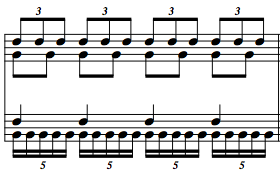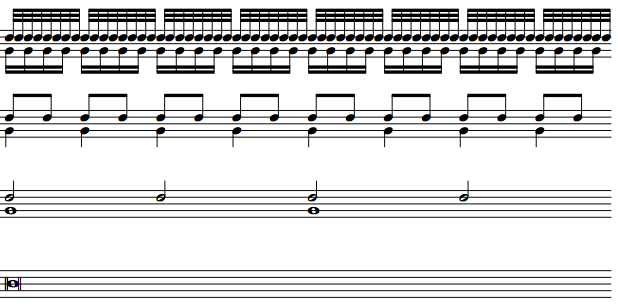Learn How to Read Rhythm
Things to learn before learning how to read rhythm:
Music is an art that requires time in which to exist. It’s not enough for music notation to tell us which notes to play, but it must also indicate when to play them and for how long. Pitch is determined by notehead placement and accidentals while rhythm is determined by filled and unfilled noteheads, stems coming out of the noteheads, and flags (or beams) coming out of the stems.
All rhythmic symbols’ lengths are relative to one another. At the moment we’re not concerned about how quickly or how slowly rhythm occurs; this answer is given to you on most musical documents. Right now our goal is to learn what the rhythmic symbols mean only in the context of one another. To do this we have to start somewhere, so we’ll start with the quarter note.
Just like in mathematics, half of a quarter is an eighth and two eighths equals a quarter. Don’t make this any more complicated: two eighth notes in succession simply means that in the time it takes to play a full quarter note, two musical events should occur. In other words, an eighth note represents an event that is half the length of a quarter note. If a second eighth note occurs in succession of the first, the second eighth note begins exactly halfway through the quarter note.
Let’s use a real example: tap out a moderate and steady pace (tempo) with your foot. Now for every time you tap your foot, clap twice and make the claps evenly spaced until a second steady pace is formed with your clapping. You are now tapping quarter notes while clapping eighth notes. This does not mean you may clap in two arbitrary places between taps. One clap is at the same time as the tap while the other is as far away from the tap before and after it as possible. It will sound exactly how it looks:
(You probably just noticed that the symbols in example 1-6 look different from the symbols used in example 1-5. When you have rhythmic symbols that use flags, the flags can be beamed together to make the groups of notes easier to recognize and perform. One week of reading rhythm will cause you to appreciate this alternate notation. For now, just know that they are synonymous.)
All of the above rhythmic proportions work in this way. Sixteenth notes are to eighth notes as eighth notes are to quarter notes. From this, you can quickly deduce that four sixteenth notes equal one quarter note. It’s simply a matter of two times two equalling four. Observe:
Now tap your foot again, and clap four times in the space of one tap. You are now clapping sixteenth notes. Thirty-second notes function in the exact same way: two thirty-second notes occur in the space of one sixteenth note. Thirty-second notes are generally too fast for most people to clap at moderate tempos, but slow the tempo down and give it a try if you like!
Now let’s go in the other direction: just as two eighth notes occur in the space of one quarter note, so two quarter notes occur in the space of one half note. This pattern goes right on through to the double whole note and it all looks like this:
If rhythmic notation stopped here, western music would be very boring (or even more boring if that’s how you feel about it). There are two symbols that are used to modify rhythmic symbols so that we are able to notate most imaginable rhythms that have the pulse you’ve been tapping with your foot. One is called the tie and it is very simple: it ties notes together so that they represent one event instead of two. So if I wanted to create a duration that lasted three quarter note pulses, I could simply tie a half note to a quarter note (as shown in example 1-9).
Example 1-10
However, this method becomes impractical and confusing when three-beat durations are used throughout an entire musical work (as it often is). For this reason, we can use a dot to add half of the original value to a note. You will often see combinations of dots and ties in order to clearly notate a variety of rhythms. (As a general rule, notes are tied in such a way as to cause note heads to occur on important pulses while dots are used to show the reader that there is nothing important happening within that duration. If that didn’t make sense, don’t worry about it; that was only an explanation for the skeptical reader; just keep reading.) Example 1-10 shows what example 1-9 looks like when a dot is
used instead of a tie.
Once again, you can apply this to all durational symbols. For example, a dotted eighth adds an additional sixteenth note to the eighth note so that it is now 50% longer than it was without the dot. In the same way, a dotted quarter note is the same length as three eighth notes tied together. Remember, before it equaled two eighth notes. Now it equals three. If you’re still confused, here’s a picture:

Example 1-11
Sometimes you will run into double dots. All that does is add an additional quarter value. So a quarter note with a double dot is the same as a quarter tied to an eighth which is tied to a sixteenth. Or, a double dot simply adds 75% of the original value.

Example 1-12

Example 1-13
Filled and unfilled noteheads, stems, flags, ties, and dots don’t quite give composers all of the options they need in order to create any rhythm they want to write. There are also tuplets, which fit any desired number of notes into a larger duration. For example, to fit three notes into one beat of space, one would write three eighth notes beamed together with a 3 sitting near the beam. Likewise, to write five notes in one beat, one would write five sixteenth notes with a five sitting near the beam. The reason for the change to sixteenths (instead of eighths) when five notes are within a beat is because the resultant rate is faster than sixteenth notes and slower than thirty-second notes. The durational symbol that is used for a tuplet changes to the next symbol when the rate which the faster symbol represents is passed (See example 1-13).

Example 1-14
Tuplets can fill more than one beat or less than one beat. For example, to write three notes in the space of a half note, three quarter notes would be bracketed together with a three sitting in the bracket. In the same way, to fit three notes into the space of an eighth note one would write three sixteenths with a three next to the beam. This same durational value can also be written by using six sixteenths beamed together with a six next to the beam (See example 1-14).
Meter
Now that we know how to read notes and rhythms, we just need to know how to organize it all. Obviously if you have 1000 notes in a piece of music, it’s going to be very difficult for two musicians to stay together (let alone an entire orchestra). So we group notes into measures which are divided by barlines. Barlines are the thin black vertical lines you see drawn through the staves throughout examples 1-11 and 1-12. They separate groups of beats into measures so that it is easier to navigate through a piece of music. As with durational notation, they occur in such a way as to make the music look like it sounds.
There are countless ways of dividing beats into measures and sometimes multiple ways are used in a single musical work. So a marking called a time signature is used to tell the reader how the beats are being grouped. Here are some examples of the most common time signatures:

Example 1-15
Please note that these time signatures have very little to do with fractions. It’s actually simpler than fractions. The bottom number refers to which durational value is to be counted in the measure. For example, the first one (4/4) tells us to count the quarter notes. Now take a look at the fourth and fifth time signatures in example 1-15. The bottom 2 in the 2/2 time signature tells us to count the half notes in the measure. 2 = half, just as 4 = quarter. Now you can deduce that 8 = eighth. The top number is even simpler; it tells us how many times that duration (to which the bottom number is referring) occurs in a measure. So if the time signature is 9/8, this means that there are 9 eighth notes in each measure (note: 6/8 and 9/8 are typically beamed into groups of three eighth notes and should be counted accordingly).

Example 1-16






